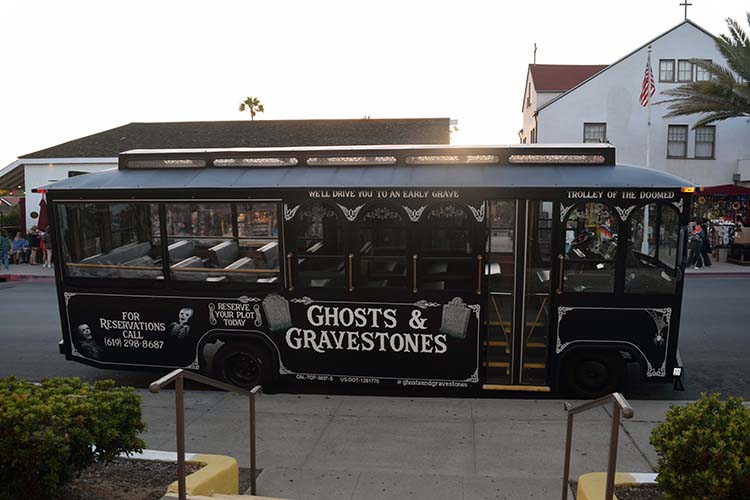
By Donald H. Harrison

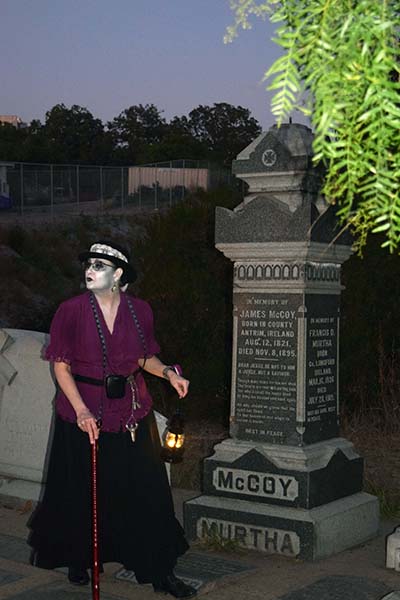
SAN DIEGO – I was shocked on Old Town Trolley’s nighttime “Ghosts and Gravestones Tour,” not by any ghosts or spirits, but while learning about the callous disregard that San Diego city administrations of the past had for graveyards and the mortal remains of people who had lived, worked, and, in some cases, had built our city.
The tour took us to two cemeteries – Pioneer Park in the Mission Hills neighborhood of San Diego, and El Campo Santo in Old Town San Diego. Many people are unaware that Pioneer Park, located next to the U.S. Grant Elementary School on Washington Place, was once the Calvary Cemetery where 2,000 people are still buried, among them such well-known figures from the city’s 19th century history as Father Antonio Ubach, who had established the Immaculate Conception Church in Old Town; Julian Ames, a president of the City’s Board of Trustees in the days prior to the formation of a city council; Cave Johnson Couts, the owner of Rancho Guajome along the San Luis Rey River; and James McCoy, who had served San Diego as a tax collector, sheriff, and state senator.
Built in the 1870s upon the urging of Father Ubach, by the 1960s the cemetery had become seriously neglected and run down, with some of the monuments deteriorating. At that point the city decided to convert the cemetery into a public park. The headstones and footstones were removed and thrown into a ditch, and the plots planted over with grass to create a well-kept rolling lawn. In the 1980s, historians sorted through some of the gravestones, finding those of the forementioned Ubach, Ames, Couts, and McCoy, among others. It was decided to line many of them up along one side of the park, with those bearing the names of less distinguished San Diegans ground up and used for paving the nearby road.
It’s an interesting coincidence that the U.S. Grant Elementary School and the row of gravestones including that of Cave Couts are on adjacent properties. Grant and Couts attended the West Point military academy at the same time.
We were guided by Deena Welch, whose face was painted a deathly white to portray the specter of the late Amy Strong, builder and first resident of the Mount Woodson Castle in Ramona. She said the future Civil War hero and U.S. President Grant graduated at the top of his West Point class whereas Couts just skated by. The U.S. Army brought Couts to San Diego as a mapmaker, and he surveyed and named many of the streets in the Old Town area.
In retelling some of the history and legends of San Diego, Strong (I’ll use the name of the character) related that Couts was passing by the Casa de Bandini (today the Cosmopolitan Hotel) in Old Town, when 18-year-old Ysidora tripped on a step and nearly fell to the ground. He caught her in his arms, their eyes locked, and a year later they were married. This was very good fortune for Couts because her father was Juan Bandini, one of the richest men at the time in San Diego. A former Peruvian of Italian heritage, Bandini had supported U.S. forces in their successful 1846 campaign against Californians loyal to Mexico. As a wedding present to Cave and Ysidora Couts, another of Bandini’s sons-in-law, Abel Stearns, presented to them Rancho Guajome, which today is a 112-acre state park.
Our guide said that Couts had his feet on both sides of the law. Well-connected, he had been appointed as a judge, but was impulsive and had a violent temper, particularly when he drank alcohol, which he did to excess. James McCoy, while sheriff, arrested Couts one year for severely beating two Native Americans who had worked at the rancho, but other judges threw the case out. Another year, Couts got into a dispute with the people in a funeral procession passing by his rancho. He thought that the body of the deceased should be burned because that was what was done with smallpox victims. However, the people said no, the man had died of old age. A quarrel broke out, and Couts fired his shotgun, killing one member of the funeral procession, wounding two others. Again, McCoy arrested him, and again the case against Couts was thrown out.
A third incident involving Couts, I had previously learned about while researching a biography I had authored, Louis Rose, San Diego’s First Jewish Settler and Entrepreneur. As guide Strong told the story, Couts had fired Mendoza from his job without giving him his back pay. Angrily, Mendoza told his friends outside a butcher shop in town that he had been cheated, and that he meant to “get” Couts. Overhearing this, from inside the butcher shop, Couts stepped out, aimed his shotgun at Mendoza, and fired it into his back, killing him. Again, Couts was arrested by McCoy.
There were witnesses to this event, including Rose who on that day in February of 1865 was a fellow member with Couts of the San Diego County Board of Supervisors. Rose testified at a coroner’s inquest that “I saw Cave J. Couts leveling or aiming with a gun at Mendoza who was running across the Plaza, When Mendoza was about 20 or 25 yards from Couts, the first shot was fired. I heard Mendoza uttering some words. I do not know what. When about 5 or 6 yards farther, I heard the second shot fire, but did not see him fall, and saw him running around Lyons’ corner. When Couts shot he was about 6 or 8 yards in front of Tebetts’ butcher shop.”
The jury decided that Couts had exercised his right of preemptive self-defense, given that Mendoza was overheard saying he intended to harm Couts. Later-day historians considered this as evidence of the racism against Mexicans that permeated 19th century San Diego society.
The people who lined up the headstones at Pioneer Park put those of McCoy and Couts, two men who had cordially hated each other, “side by side for eternity,” Strong commented. “Now wasn’t that nice of them?”
They were much nicer, I thought, than the people who simply created a community park under which the bodies of 2,000 people lay mostly forgotten. Strong, relating legends of ghosts and spirits, commented, “You can imagine, the people who are buried here in this cemetery are not happy. They say in the wee hours of the night, the park is very active with lots and lots of spirits. We do know that a very distraught woman and wife walks the edge of the park and when she gets close to any of the houses, all their electronic devices go haywire. Their microwaves go on and off, their television set monitors display ‘snow.’”
Such disregard for the final resting places of the dead was also a disturbing fact about El Campo Santo, the small cemetery on San Diego Avenue in the Old Town neighborhood. Strong reported later in the tour that 477 burials took place there between 1849 and 1897, but only a relatively few plots are visible in the small fenced cemetery. “El Campo Santo cemetery actually goes out about 2 ½ blocks from here,” she advised her tour group. “The people who were buried out there either were criminals, people long forgotten about, or they just no longer had markers. So, in the 1930s, the city decided to just go out and pave right over on San Diego Avenue.”
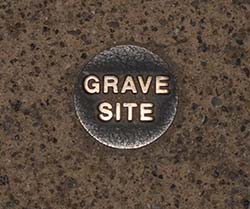
“In 1993, there were a bunch of students from UCSD who came out with radar equipment,” Strong added. “They wanted to see how far out the cemetery actually went and if they could spy any of the bodies that were buried beyond the walls. When they found them, they wanted to go ahead and mark them. … When you look down onto the sidewalk and even onto the street you are going to see these coin-shaped markers on the grave sites. … These grave markers go all the way down this side of San Diego Avenue. They do say that the vehicles that park on this side of San Diego Avenue often will have car trouble. The alarms go off for no apparent reason, or when they get back into the vehicle, their starters won’t turn over, or the batteries will be drained. They do believe that the spirits that they are on top of are not happy about them being there.”
One of the El Campo Santo gravesites to which Strong drew special attention was that of Yankee Jim Robinson, a tall man who favored red shirts, who was instantly recognized in Southern California as the man who had robbed gold from miners and horses from ranchers in Northern California. After he arrived here, with two companions, he stole a rowboat hoping to loot a pilot boat in the harbor. But the master of the pilot vessel, Captain Keating, was still aboard and fired his shotgun at the three would-be thieves. Robinson’s two companions were caught quickly, but Robinson eluded capture for several days. Brought before a judge, the two companions were both sentenced to a year in prison each, but to Robinson’s surprise, he was sentenced to be hanged until death. According to Strong, Robinson did not believe there could be such a disparity in sentencing. Up until the time the floor beneath the gallows opened up under him, he thought it was all just a joke to scare him.
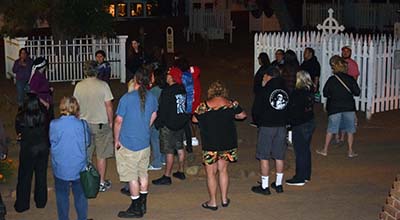
Because he was so tall, Robinson’s feet scraped against the ground below the gallows, and it took a long time for him to be strangled. The coffin that was prepared to receive his body was too small, forcing those burying him to fold his body nearly in half to get him into the box. According to Strong, “Yankee Jim does not rest well here in his resting place and in fact his spirit can be seen strolling up San Diego Avenue heading to the gallows so he can take his revenge.”
The gallows were located a couple of short blocks up San Diego Avenue on the property now occupied by the Whaley House, which is advertised as the most haunted house in America, with 33 spirits said to reside there.
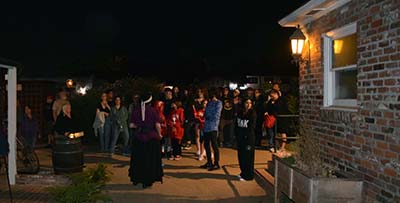
One of them is Yankee Jim Robinson; several of the others are members of 19th century businessman Thomas Whaley’s family, including himself. Supposedly, Whaley’s spirit smells of pipe tobacco, while his wife Anna’s spirit gives off the scent of lavender perfume. One of the saddest stories is about a granddaughter who committed suicide because she could not shake her depression after separating from a husband who had lied to her about his past and his philandering, but whom she continued to love.
Perhaps I was shocked by the stories of the two cemeteries because in our Jewish tradition, we are taught to hold the dead in reverence. We refer to some of our departed friends and relatives as being “of blessed memory,” and we wish “may peace be upon them.” We hope their memories “will be a blessing” and that the “merit” they earned in their lifetimes might “shield us.” Certainly, observant Jews would protest fervently against a cemetery being defaced, or God forbid, being planted or paved over to make room for a city park or a road.
*
Donald H. Harrison is editor emeritus of San Diego Jewish World. He may be contacted via donald.harrison@sdjewishworld.com